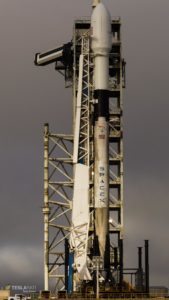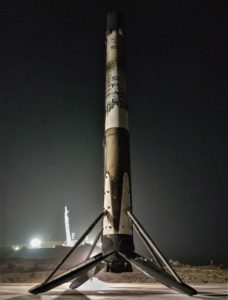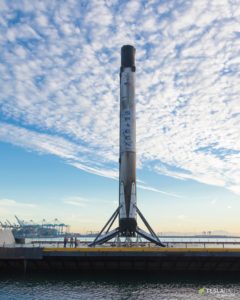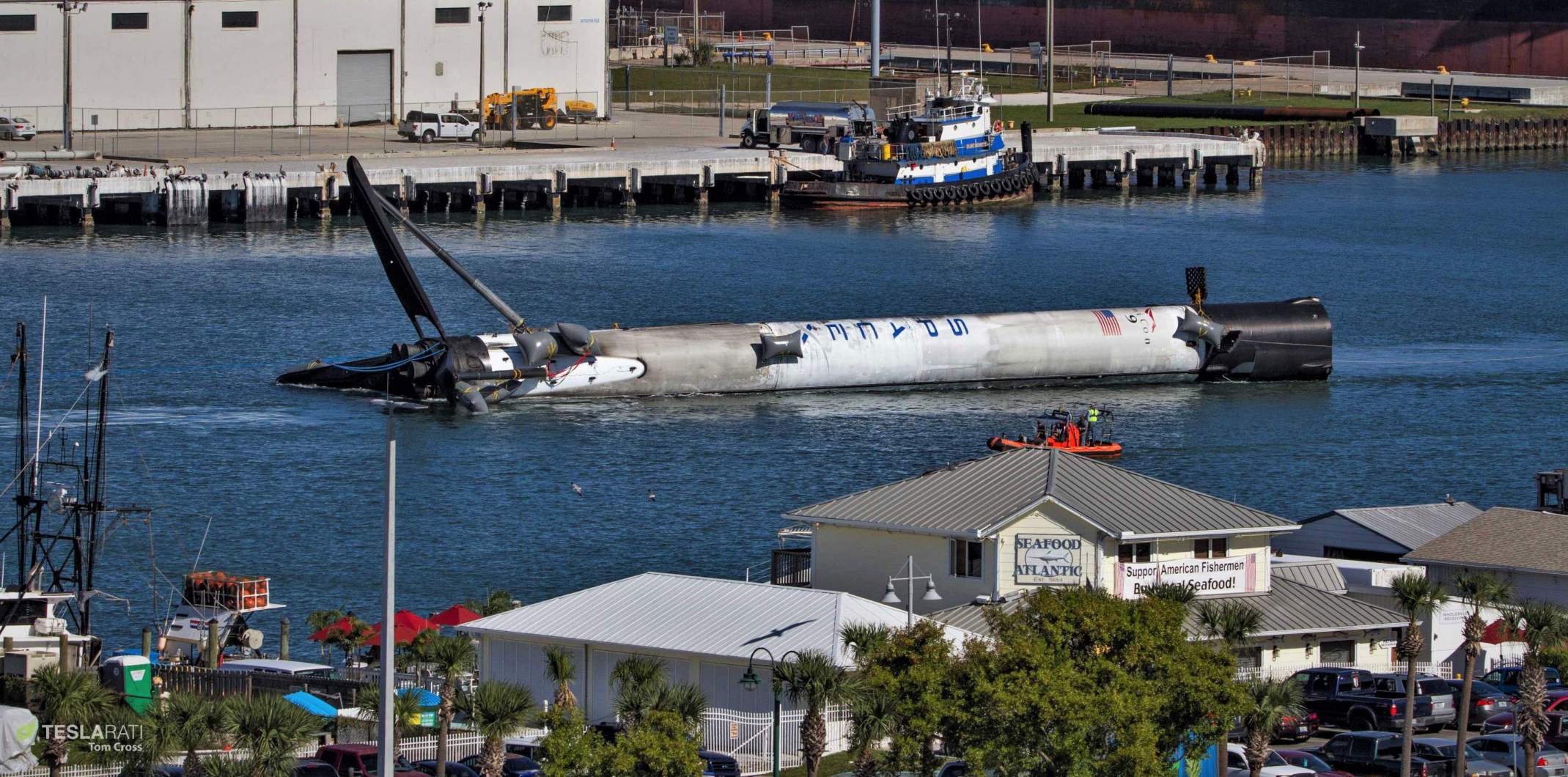
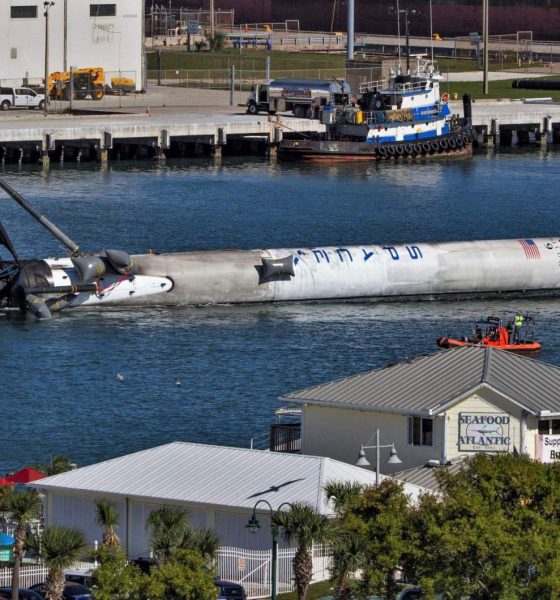
News
SpaceX’s partial Falcon 9 landing failure could delay next West Coast launch
According to statements made by the Canadian Space Agency (CSA) and media outlet CBC, the launch of the agency’s next-generation Radarsat Constellation Mission (RCM) – a trio of Earth observation satellites weighing >4200 kg (9300 lbs) – has been “postponed … indefinitely” as a consequence of SpaceX’s first failed Falcon 9 booster landing since 2016.
Offering a rare glimpse into some of the extensive planning that goes on behind the scenes to make commercial rocket launches happen, CSA has indicated that the booster it planned to launch on – Falcon 9 B1050 – suffered an untimely (partial) demise during a recovery attempt shortly after successfully launching the CRS-16 Cargo Dragon mission on December 5th, 2018. While the booster shockingly was returned to dry land mostly intact after landing in the Atlantic, SpaceX and CSA must now settle on a different Falcon 9 to launch the mission.
A problem with a SpaceX booster rocket has postponed the launch of a $1 billion Canadian satellite program indefinitely. https://t.co/45qirdId5j @DeanBeeby
— CBC News (@CBCNews) January 15, 2019
Goldilocks and the Falcon boosters
While it doesn’t look like there are only three possible rocket options for the Radarsat constellation and SpaceX to choose from, the situation of picking a new booster this late in the launch flow is far less simple than it might initially seem. First and foremost, SpaceX likely needs to do its best to accommodate the preferences of customers CSA and MDA (MacDonald, Dettwiler and Associates Ltd.) regardless of how disruptive they may be. Originally targeted for sometime in November 2018, RCM’s launch slipped several months to the second half of February 2019 due to what CSA described as “higher priority missions [for]the US Government and a backlog of launches from…Vandenberg” late last year.
While that alone does not point directly towards any obvious explanations, CBC reporter Dean Beeby’s implication that the mission’s launch is now “postponed…indefinitely” offers a hint of an answer, although it could also be manufactured hyperbole where there actually is none. If CSA actually indicated that the launch is now postponed indefinitely, the only clear explanation for a launch delay greater than a month or so as a result of Falcon 9 B1050’s unplanned unavailability would lie in some unique aspect of that particular Falcon 9 booster.
Although each rocket SpaceX builds can be quite different from each other in terms of general quirks and bugs, the only obvious difference between B1050 and any other flight-proven Falcon 9 booster in SpaceX’s fleet was its low-energy CRS-16 trajectory, something that would have enabled a uniquely gentle reentry and landing shortly after launch. In other words, likely out of heaps of caution and conservatism if it is the case, customers CSA and MDA may have requested (or contractually demanded) that SpaceX launch the Radarsat constellation on a flight-proven Falcon 9 with as little wear and tear as possible, in which case B1050 would have been hard to beat.
“Unfortunately, the landing of [Falcon 9 B1050] was unsuccessful, preventing SpaceX from recuperating the reusable components for the launch of RCM. We continue to work closely with MDA and SpaceX to confirm a launch date for RCM.” – Spokesperson Audrey Barbier, Canadian Space Agency (CSA), 01/15/2019
If the customers remained steadfast in their (speculated) request for a gently-used flight-proven Falcon 9 even after B1050’s partial landing failure, the next most comparable booster would be Falcon 9 B1051 after launching the first orbital Crew Dragon mission sometime no earlier than (NET) February 2019. Aside from B1051, there will be no obvious booster alternative available for at least several months after Crew Dragon’s launch debut, unless NASA requests that its next contracted Cargo Dragon mission (CRS-17) launch on a new Falcon 9 rocket in March 2019.
Engines stabilized rocket spin just in time, enabling an intact landing in water! Ships en route to rescue Falcon. pic.twitter.com/O3h8eCgGJ7
— Elon Musk (@elonmusk) December 5, 2018
Warmer…
If a less lightly-used booster becomes an option for CSA/MDA, there are immediately multiple clear options available as long as SpaceX is will to accept possible delays to subsequent launches to quickly reassign a flight-proven Falcon 9. Falcon 9 B1046 – the first SpaceX rocket ever to launch three orbital-class missions – is being refurbished at SpaceX’s Hawthorne, California facilities a few hundred miles south of Vandenberg. B1047 completed its second successful launch in November 2018 and is being refurbished – along with the twice-flown B1048 – in Cape Canaveral, Florida. Finally, Falcon 9 B1049 completed its second successful launch just days ago (January 11th) and is being processed off of drone ship Just Read The Instructions (JRTI) at this very moment.
B1047 or B1048 have likely been assigned to the imminent NET February 18th launch of Indonesian commsat PSN-6 and SpaceIL’s Beresheet Moon lander, meaning that the best possible option for Radarsat – short of swallowing months of additional delays – is a decision between B1047/B1048 or B1046, with B1049 also a candidate if a slip into March or April is an option. Still, all of those options would require Canada and MDA to fly on a Falcon 9’s third (or fourth) launch, perhaps an unacceptable compromise or perceived risk for certain customers.
- Falcon 9 B1046 is processed in Port of LA shortly after its third successful launch and landing, December 2018. (Pauline Acalin)
- Falcon 9 B1047 is pictured here beneath an upper stage and satellite Es’hail-2 prior to its second launch. (Tom Cross)
- Falcon 9 B1048 landed at LZ-4 after its second launch and is now being refurbished on the opposite coast. (SpaceX)
Meanwhile, schedule pressures have meant that SpaceX is pushing as hard as possible to prepare three new Block 5 Falcon Heavy boosters for the giant rocket’s second and third launches, scheduled as early as March and April 2019. While unconfirmed, it appears that SpaceX may have chosen to manufacture all three of those boosters one after the other, meaning that the company’s Hawthorne factory would have been primarily focused on delivering those rockets for at least 2-3 months start to finish. In short, it does not appear that there is or will be an unflown Falcon 9 booster available for Radarsat anytime soon.
Whether the customers wait for a new booster to be produced, wait for Crew Dragon’s first launch to wrap up, or accept being the third or fourth launch of a well-scorched Falcon 9, RCM’s next published launch target should offer a hint as to how CSA, MDA, and SpaceX ultimately decided to respond to Falcon 9 B1050’s dip in the Atlantic OCean.

News
Tesla is not sparing any expense in ensuring the Cybercab is safe
Images shared by the longtime watcher showed 16 Cybercab prototypes parked near Giga Texas’ dedicated crash test facility.

The Tesla Cybercab could very well be the safest taxi on the road when it is released and deployed for public use. This was, at least, hinted at by the intensive safety tests that Tesla seems to be putting the autonomous two-seater through at its Giga Texas crash test facility.
Intensive crash tests
As per recent images from longtime Giga Texas watcher and drone operator Joe Tegtmeyer, Tesla seems to be very busy crash testing Cybercab units. Images shared by the longtime watcher showed 16 Cybercab prototypes parked near Giga Texas’ dedicated crash test facility just before the holidays.
Tegtmeyer’s aerial photos showed the prototypes clustered outside the factory’s testing building. Some uncovered Cybercabs showed notable damage and one even had its airbags engaged. With Cybercab production expected to start in about 130 days, it appears that Tesla is very busy ensuring that its autonomous two-seater ends up becoming the safest taxi on public roads.
Prioritizing safety
With no human driver controls, the Cybercab demands exceptional active and passive safety systems to protect occupants in any scenario. Considering Tesla’s reputation, it is then understandable that the company seems to be sparing no expense in ensuring that the Cybercab is as safe as possible.
Tesla’s focus on safety was recently highlighted when the Cybertruck achieved a Top Safety Pick+ rating from the Insurance Institute for Highway Safety (IIHS). This was a notable victory for the Cybertruck as critics have long claimed that the vehicle will be one of, if not the, most unsafe truck on the road due to its appearance. The vehicle’s Top Safety Pick+ rating, if any, simply proved that Tesla never neglects to make its cars as safe as possible, and that definitely includes the Cybercab.
Elon Musk
Tesla’s Elon Musk gives timeframe for FSD’s release in UAE
Provided that Musk’s timeframe proves accurate, FSD would be able to start saturating the Middle East, starting with the UAE, next year.

Tesla CEO Elon Musk stated on Monday that Full Self-Driving (Supervised) could launch in the United Arab Emirates (UAE) as soon as January 2026.
Provided that Musk’s timeframe proves accurate, FSD would be able to start saturating the Middle East, starting with the UAE, next year.
Musk’s estimate
In a post on X, UAE-based political analyst Ahmed Sharif Al Amiri asked Musk when FSD would arrive in the country, quoting an earlier post where the CEO encouraged users to try out FSD for themselves. Musk responded directly to the analyst’s inquiry.
“Hopefully, next month,” Musk wrote. The exchange attracted a lot of attention, with numerous X users sharing their excitement at the idea of FSD being brought to a new country. FSD (Supervised), after all, would likely allow hands-off highway driving, urban navigation, and parking under driver oversight in traffic-heavy cities such as Dubai and Abu Dhabi.
Musk’s comments about FSD’s arrival in the UAE were posted following his visit to the Middle Eastern country. Over the weekend, images were shared online of Musk meeting with UAE Defense Minister, Deputy Prime Minister, and Dubai Crown Prince HH Sheikh Hamdan bin Mohammed. Musk also posted a supportive message about the country, posting “UAE rocks!” on X.
FSD recognition
FSD has been getting quite a lot of support from foreign media outlets. FSD (Supervised) earned high marks from Germany’s largest car magazine, Auto Bild, during a test in Berlin’s challenging urban environment. The demonstration highlighted the system’s ability to handle dense traffic, construction sites, pedestrian crossings, and narrow streets with smooth, confident decision-making.
Journalist Robin Hornig was particularly struck by FSD’s superior perception and tireless attention, stating: “Tesla FSD Supervised sees more than I do. It doesn’t get distracted and never gets tired. I like to think I’m a good driver, but I can’t match this system’s all-around vision. It’s at its best when both work together: my experience and the Tesla’s constant attention.” Only one intervention was needed when the system misread a route, showcasing its maturity while relying on vision-only sensors and over-the-air learning.
News
Tesla quietly flexes FSD’s reliability amid Waymo blackout in San Francisco
“Tesla Robotaxis were unaffected by the SF power outage,” Musk wrote in his post.

Tesla highlighted its Full Self-Driving (Supervised) system’s robustness this week by sharing dashcam footage of a vehicle in FSD navigating pitch-black San Francisco streets during the city’s widespread power outage.
While Waymo’s robotaxis stalled and caused traffic jams, Tesla’s vision-only approach kept operating seamlessly without remote intervention. Elon Musk amplified the clip, highlighting the contrast between the two systems.
Tesla FSD handles total darkness
The @Tesla_AI account posted a video from a Model Y operating on FSD during San Francisco’s blackout. As could be seen in the video, streetlights, traffic signals, and surrounding illumination were completely out, but the vehicle drove confidently and cautiously, just like a proficient human driver.
Musk reposted the clip, adding context to reports of Waymo vehicles struggling in the same conditions. “Tesla Robotaxis were unaffected by the SF power outage,” Musk wrote in his post.
Musk and the Tesla AI team’s posts highlight the idea that FSD operates a lot like any experienced human driver. Since the system does not rely on a variety of sensors and a complicated symphony of factors, vehicles could technically navigate challenging circumstances as they emerge. This definitely seemed to be the case in San Francisco.
Waymo’s blackout struggles
Waymo faced scrutiny after multiple self-driving Jaguar I-PACE taxis stopped functioning during the blackout, blocking lanes, causing traffic jams, and requiring manual retrieval. Videos shared during the power outage showed fleets of Waymo vehicles just stopping in the middle of the road, seemingly confused about what to do when the lights go out.
In a comment, Waymo stated that its vehicles treat nonfunctional signals as four-way stops, but “the sheer scale of the outage led to instances where vehicles remained stationary longer than usual to confirm the state of the affected intersections. This contributed to traffic friction during the height of the congestion.”
A company spokesperson also shared some thoughts about the incidents. “Yesterday’s power outage was a widespread event that caused gridlock across San Francisco, with non-functioning traffic signals and transit disruptions. While the failure of the utility infrastructure was significant, we are committed to ensuring our technology adjusts to traffic flow during such events,” the Waymo spokesperson stated, adding that it is “focused on rapidly integrating the lessons learned from this event, and are committed to earning and maintaining the trust of the communities we serve every day.”

